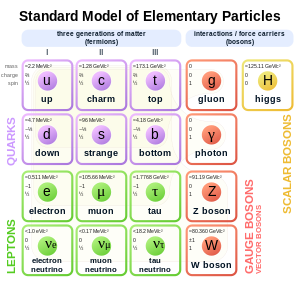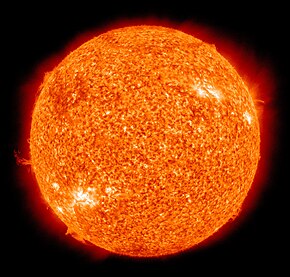In this post, I'm going to show you what I'm really made of.
Yep, that's it. In fact, that's what the universe is made of. Twelve particles of matter, four fundamental forces. This is what is called the Standard Model of particle physics. Everything, absolutely everything, with no exceptions, can be broken down at base into these things. The interactions of these twelve particles and four forces are the cause of absolutely all phenomena. We are very close to understanding these interactions to a very high degree of accuracy, and we are also close to being able to plug the numbers into a computer and have it start calculating, and have it end up predicting everything within certain levels of probability. But obviously, I'm more than just quarks and gluons. I'm a human being, a living thing, and a thing with a mind. As Carl Sagan put it, the beauty of a living thing is not the atoms that go into it, but the way those atoms are put together. So, how did this stuff end up turning into me?
These elementary particles have to come together as composite particles before we can even start to build atoms, which are the smallest pieces of elements. The nucleus of an atom is made of protons and neutrons, and that nucleus is surrounded by a cloud of electrons. Yes, its a cloud even in a hydrogen atom, where there is one electron. Protons and neutrons are made of three quarks each; a proton is two up quarks and a down quark, while a neutron is two downs and an up. The quarks are held together by one of the four forces, the strong nuclear force (which is also gluons). The nucleus of a relatively large atom looks a little bit like this:
Now, that's only an approximation, because in reality, all of those particles are in many different places at the same time. When you look at them, they are only probably going to be in any given place. These particles are held together by the nuclear force, which is really just the residual bits of the strong force holding the quarks together. This nucleus, as I noted, is relatively large. All of the atoms of heavier elements, and by that I mean anything with an atomic number 3 and up, started out as much simpler atoms than this one. They all looked kind of like this:
That's hydrogen, specifically protium. It has one proton and one electron, and most of the stuff in the universe still looks like this. About 75% of the chemical matter in the universe is hydrogen, and about 99.98% of hydrogen is protium. At one point, you were this. I was this. Everything you see was this. These particles were formed when the universe was born, about 13.7 billion years ago. So in that sense, you are 13.7 billion years old. The particles that compose my body are as old as the cosmos. Obviously, I'm not made of hydrogen. A big part of me is, because the second most common molecule in the universe is a large percentage of my body. The most common molecule is of course hydrogen gas, H2. Helium doesn't form bonds. The next most common element is oxygen, and since there's a lot of hydrogen and oxygen, they combine to form H2O. Water. So I've got a lot of hydrogen in me, but I've got other stuff too. Obviously, I've just mentioned oxygen. There's also carbon, iron, and various other elements. Where did all that come from? Well, when you put a whole lot of hydrogen together, another force takes over: gravity. It starts pulling all of the hydrogen into a ball, and crushing it together in the center. It eventually looks like this:
That's a star, specifically our Sun. Its emitting a lot of energy, partly in the form of heat and light, because in the middle, gravity is pushing the hydrogen atoms together. Normally, they're held apart by the electromagnetic force, which is much weaker than the strong nuclear force, but holds up better over distance. Gravity is much weaker than the electromagnetic force, but its even better at working at a distance, and the more matter you have, the stronger it gets. When a proto-star gets big enough, the gravity pushes the nuclei close enough that the strong nuclear force beats out electromagnetism, and the atoms snap together in a process called thermonuclear fusion. The energy the particles release when they fuse is greater than the energy needed to push them together, and the star ignites. At its core, our Sun and every other star is fusing hydrogen into helium. Our Sun, amazingly enough, isn't big enough to go on to the next stage when it eventually runs out of hydrogen. Bigger stars start fusing hydrogen into carbon through the triple-alpha process when they near the end of their lives. Really big stars go on to fuse lighter elements into iron. But going any heavier than that stops releasing energy; it takes more energy to fuse the nuclei than they release when it happens. So what made all the elements heavier than iron? There are a lot of them. That process might look a little something like this:
The incredibly huge stars explode when they reach the end of their lives; they've fused everything they can into iron, and something has to give. Fusion isn't making more energy, but gravity just won't let up. They release truly apocalyptic amounts of energy in what is called a supernova. Such a destructive event would wipe out all life in every nearby solar system. Whole planets would be utterly destroyed, and even other stars might be swept up in the massive explosion. Supernovae observed from Earth can outshine the entire galaxy in which the star resides. One explosion outshining hundreds of billions of stars. But in the midst of all that energy being released, lots of atoms are being slammed together with tremendous force. And we get supernova nucleosynthesis. All the heavier elements, everything with an atomic number higher than 56, gets made when the biggest of stars die. Stars that burned billions of years ago and uncounted light years away died, so that you could be here today reading this article. On YouTube, philhellenes said it quite well: Stars must die so that I can live. I stepped out of a supernova.
And so did you.
So, what am I really made of? Energy. Quarks. Atoms. Molecules.
Stars.
I'm pretty awesome. You are, too.





I'm little more awesome than you, I'm Croatian.
ReplyDelete:):) Just kidding.
Excellent basics Matt. Really. You could be theistic atheist.
What do you think electron is made of? Of course you know,condensed energy.
Big question is what is keeping that energy from dispersing, in a precise bundle, the same way all across universe?
Also what is the energy electron (and other particles) are made of?
My favorite physicist, Feynman was always an honest man. His words:
"There is a fact, or if you wish, a law governing all natural phenomena that are known to date. There is no known exception to this law – it is exact so far as we know. The law is called the conservation of energy.
It states that there is a certain quantity, which we call “energy,” that does not change in the manifold changes that nature undergoes. That is a most abstract idea, because it is a mathematical principle; it says there is a numerical quantity which does not change when something happens.
It is not a description of a mechanism, or anything concrete; it is a strange fact that when we calculate some number and when we finish watching nature go through her tricks and calculate the number again, it is the same."
The law of conservation of energy is indeed pretty nifty, and very elegant in its simplicity. Feynman is one of my favorites as well; he said the following which is rather fitting during the Feynman Lectures: "It is important to realize that in physics today, we have no knowledge what energy is. We do not have a picture that energy comes in little blobs of a definite amount."
ReplyDeleteIts certainly something that is fun to imagine, something that I look forward to learning more about as science digs deeper into reality.
"I look forward to learning more about as science digs deeper into reality."
ReplyDeleteSame here.
Another favorite physicist of mine, Nobel Prize winner Frank Wilczek explains space as multi layered, transparent,superconducting framework he calls The Grid. The Grid seem to permeate the whole of space and is integrated with space to provide scaffold of reality, our playground. It may sound a bit New Age but it's not. It's based on latest and possibly deepest understanding of physics.
http://www.frankwilczek.com/